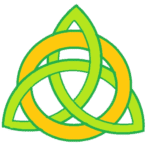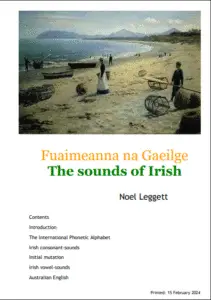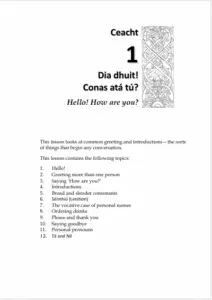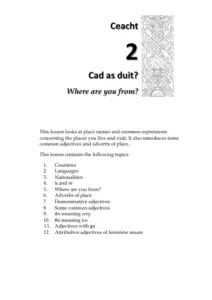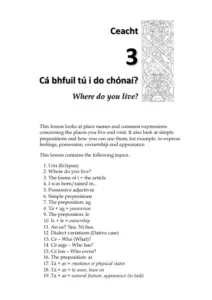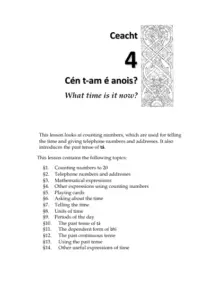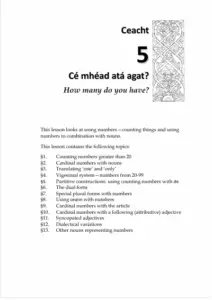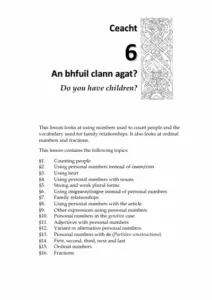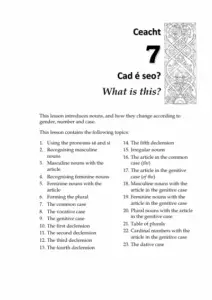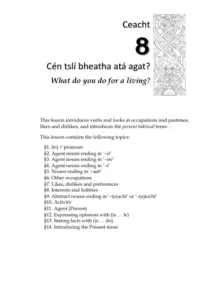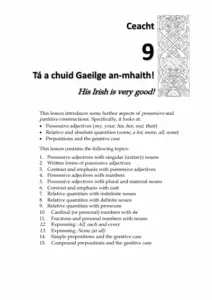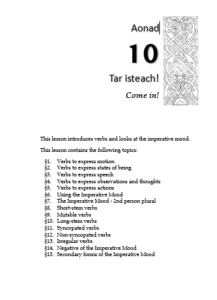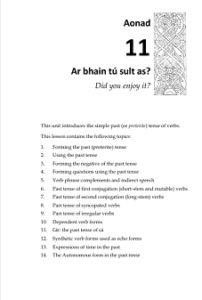This page contains files for exclusive download by members of the Irish Language School, Sydney.
Table of Contents
Fuaimeanna na Gaeilge
(The Sounds of Irish)
a guide to Irish pronunciation and spelling
This pronunciation and spelling guide is an indispensible aid to understanding the sounds of the Irish language, its concepts and characteristic sound changes.
There’s an accompanying online course (coming soon) as well as documents to download.
Fiche nóiméad sa lá
(Twenty minutes a day)
A functional approach to learning Irish
The course is delivered in 10 parts. Each part contains three units.
For every unit, you can download a reference booklet (PDF), containing grammar notes and exercises.
Coming soon: Each unit features up to six short lessons, focusing on a single pattern, which you can review in an online multimedia post with a downloadable PDF presentation file.
Each unit also includes links to Memrise Community Courses, with interactive multimedia flashcards based on each lesson, to help you practise.
Part 1: Introduction to the Irish language
The first part contains three units, which start with simple sentences for basic conversation in Irish, including:
- Greetings, introductions and pleasantries;
- Ordering drinks at the bar;
- Defining and describing the weather, people and objects;
- Talking about countries, people and languages;
- Saying where you live;
- Describing where something or someone is located.
This part introduces you to the fundamental characteristics of the Irish sound system.
It focuses on the sounds and sound changes that feature in every Irish word and sentence:
- leathan (broad) and caol (slender) consonants
- séimhiú (softening) – ‘lenition’
- urú (eclipsis) – the ‘nasal’ mutation
- análú (breathing) – ‘h-prothesis’
Part 2: All about numbers
This part contains three units all about how numbers are used in Irish.
While learing how to count, tell the time, discuss quanities of things, and talk about your family, you’ll learn how to use:
- Maoluimhreacha (counting/‘bare’ numbers) – used independently
- Bunuimhreacha (cardinal/‘basic’ numbers) – used with nouns
- Uimhreacha pearsanta (personal numbers) – used mainly with people
- Orduimhreacha (ordinal numbers) and codain (fractions)
Part 3: All about nouns
Irish is a very ‘noun-centred’ language. Nouns do a lot of the ‘heavy lifting’ in the Irish language, and they can change their appearance according to their function.
This part contains three units that give you a complete understanding of how nouns work in Irish.
While discussing your job, pastimes and hobbies, you’ll learn how to form the plural of nouns, get a better understanding of the case system, and use nouns in various combinations.
Part 4: Introducing verbs
Although Irish nouns do most of the ‘heavy lifting’ in the language, there is still a lot to learn about verbs.
We’ll learn a core group of about 60 regular verbs, which along with the 11 irregular verbs, is just about all you need to build a solid foundation in conversational Irish. (Yes, that’s right! Irish has only 11 irregular verbs!) Each week, we’ll look at a new tense or a set of patterns, and learn how they are used in conversation.
You’ll discover that with just a few verbs, you can say a great deal.
In this part, we start with verbs in their simplest, most basic forms, and their most common uses in everyday conversation: requests and talking about past events.
Unit 12
What did you do?
Part 5: States, stories and plans
In this part, we’ll expand on what we already know about describing current, recurring and future events.
Not only do we learn more about the present and future tenses, but also about verbal ‘aspects’ and how to look at things from various prespectives.
From here, we can move from basic ‘question and answer’ patterns to exploring ‘narrative’ patterns, adding depth and context to sentences, so that you can understand and tell ‘stories’, and describe how events unfolded.
Unit 13
Where are you going?
Unit 14
Do you come here often?
Unit 15
What will you have to drink?
Part 6: Memory, determination and imagination
In this part, we’ll use verbs to explore the the mind.
By learning the imperfect and conditional tenses, you can look at the past from a different perspective, and describe hypothetical situations and events, possibilities and probabilities, and add greater range and nuance to your conversation.
Unit 16
Did you used to play tennis?
Unit 17
Would you have a cup of tea?
Unit 18
What would you do?
Part 7: Comparison, direction and detail
In this part, we leave verbs for a month, while we expand on what we already know about adjectives, adverbs and prepositions.
We’ll look at patterns for comparing things – indispensible for shopping and poetry. You’ll discover why asking for directions in Irish is so much better than English. And you’ll learn how to build complex sentences using relative clauses, to further enhance your conversation.
Unit 19
Do you have anything smaller?
Unit 20
Come over here!
Unit 21
Is that the house you stayed in?
Part 8: The consumate conversationalist
In this part, we return to verbs to finish off our knowledge by learning how to master some unique features of the Irish language that are often neglected by learners of Irish as a second language, but are in constant use among natural speakers.
You’ll learn how to express hopes and wishes, to pray (and curse) like a native, using the subjunctive mood. You’ll learn to distinguish between ‘autonomous’ and ‘passive’ forms to keep your conversation clear and concise. You’ll learn to manipulate word order to emphasize or clarify a point, and be better understood.
Unit 22
May the road rise with you!
Unit 23
How is that spelt?
Unit 24
Which do you prefer?
Part 9: Kissing the Blarney stone
In this ‘final’ part, we round off our journey by reviewing and expanding on our knowlege of how words and sentences are built in the Irish ‘idiom’. We’ll also review and learn more about the variety of Irish dialects and historical spelling that you’re likely to encounter.
We’ll summarise our knowledge of word-building, idiomatic expressions using verbs, nouns and prepositions, so that you can continue your learning journey with a thourough understanding of ‘how Irish works’. With the confidence that understanding affords, you can go forth to explore centuries of Irish history and culture through its literature and song, and celebrate its continued vibrancy as a living language.
Unit 25
Wouldn't that make you thirsty?
Unit 26
Do you know about that?
Unit 27
Forty shades of green
Part 10: 'Drinking from Amergin's well' - Irish literary traditions
These lessons are generally presented during course of the year, as the situation allows.
Unit 28
Scéalta as Gaeilge
Tales, stories and legends told in Irish: familiar, literary and contemporary; from mythological cycles to Pádraic Piarais to Dymphna Lonergan.
Readings may include:
- Táin Bó Cuailnge
- Fuinneog an Bháis
- An Prionsa Sona
- An Dearg-Daol
- Na Ceannlínte
Unit 29
An Filíocht nua
Themes in contemporary Irish poetry since 1950.
Including poetry by (for example):
- Caitlín Maude
- Nuala Ní Dhomhnaill
- Louis de Paor
- Cathal Ó Searcaigh
Unit 30
Amhráin na nGael
The development of the traditional Irish song form, from sean-nós, to Thomas Moore to today.
Songs may include:
- An Droighneán Donn
- Eochaill
- Cólín Phádraig Shéamais
- Beidh Aonach Amárach
- An Mhaighdean Mhara
- Róisín Dubh
- An Cailín Deas ag Crúite na mBó
